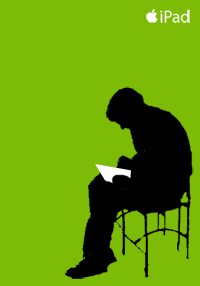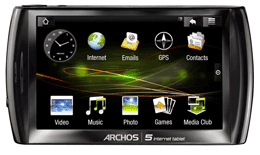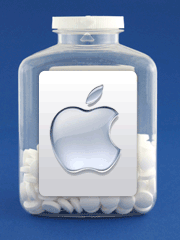I had fun guesting on CNET’s Reporters’ Roundtable today, talking about tablets with host Rafe Needleman and fellow visitor Ryan Block of Gdgt. For some reason I’m having trouble embedding the video, but you can watch it here.
Tag Archives | Tablets
I’m on CNET TV Today
 I’m tickled to report that I’m going to be a guest today on Reporters’ Roundtable, a new CNET podcast. I’ll be in excellent company: The host is Webware’s Rafe Needleman and Gdgt’s Ryan Block is also guesting. And the topic’s a fun one: the past, present, and future of tablet computers.
I’m tickled to report that I’m going to be a guest today on Reporters’ Roundtable, a new CNET podcast. I’ll be in excellent company: The host is Webware’s Rafe Needleman and Gdgt’s Ryan Block is also guesting. And the topic’s a fun one: the past, present, and future of tablet computers.
The show is taping at 1pm PDT, and you can watch us live. The recorded version will show up here. Check it out, won’t you?
No comments
5Words: Tablets Come Into Focus
 Tablets: finally coming into focus?
Tablets: finally coming into focus?
Windows Mobile 6.5 phones arrive.
A massive Hotmail password leak?
Matt Cutts is avoiding Microsoft.
Does Mozilla fear Chrome Frame?
Android on Verizon by Christmas?
iPhone Documents to Go spreadsheet.
________________________
Like 5Words? Subscribe via RSS.
No comments
Magazines: Still Ripe for Digital Reimagining
 We don’t even know for sure whether Apple will ever release a tablet–although there’s lots of compelling evidence that it will–and already there’s a lively debate about whether the company is interested in using said tablet to do to printed reading materials what iTunes has done for music.
We don’t even know for sure whether Apple will ever release a tablet–although there’s lots of compelling evidence that it will–and already there’s a lively debate about whether the company is interested in using said tablet to do to printed reading materials what iTunes has done for music.
Until recently, the smart money seemed to be on Apple staying out of the e-reader fray–cue references to Steve Jobs saying that nobody reads anymore. But over at Gizmodo, Brian Lam is reporting that Apple has been in talks with publishers of textbooks, newspapers (the New York Times, specifically), and magazines–presumably as it gets ready to announce its tablet. Maybe the company is interested in catering to those of us who do read after all.
I hope so–and as a former magazine guy, I’m most interested to see what Apple might do with the medium I left behind but for which I’ll never lose my affinity. For all the things that are right with Amazon.com’s Kindle e-book reader, its treatment of magazines is pretty horrible. It may have signed deals to offer thirty-six well-known titles, but every Kindle magazine I’ve seen has been stripped of most of its formatting, graphics, and…life. There’s no particular benefit to Kindle magazines except for saving some trees and space on your coffee table, especially when far more dynamic, engaging, interesting versions of most of the same content is available for free on the Web.
And ultimately, I don’t think largely static downloadable magazines such as those offered by Amazon (as well as PDF-like print replicas such as Zinio versions) are going to revolutionize anything. We don’t need new formats for magazines that compete with the Web–we need to use Web technologies to create more compelling digital versions of traditionally pulp-based publications. An electronic version of, say, the New Yorker shouldn’t be an entirely different beast from NewYorker.com. It should be a variant that can be pushed to a device (be it from Amazon or Apple) and read even when you’re offline, with slicker type, graphics, and overall presentation than the Web currently permits. And what the heck–it should retain the wonderfully browsable, print-oriented concepts of a cover, a table, of contents, and a sequence of pages from beginning to end. (In this case, it should also involve cartoons interspersed throughout, which you can choose to read first.)
Like Web pages, these magazines should work on multiple devices from different manufacturers–if Newsweek is available in slightly different, incompatible variants for the Kindle and Apple’s tablet, it’s just going to drive everybody crazy.
Oh, and whoever solves this problem needs to figure out issues of screen orientation–one of the big gotchas with Zinio magazines is that they’re portrait-oriented publications in the mostly landscape-oriented world of computer displays.
I don’t know if Brian’s story is right on the money–and if it is, I have no idea what Apple has in mind. But I do know that even though I don’t currently subscribe to any digital magazines, I’d happily plunk down my money for ones that got the format right. So far, nothing’s come close. I’m a happy optimist, so I’m assuming this will get solved relatively soon–if not by Apple, by somebody.
3 comments
More “Details” on the Apple Tablet
 iLounge has a story with what it says are ten new details about the impending Apple tablet device. None of them are shockers, and most repeat tidbits that have already been out there: The site says that the gadget has a 10.7″ screen, runs iPhone OS, will be available in 3G and non-3G versions, has seven times the screen resolution of an iPhone, and will be announced on or before January 19, 2010 and ship in May or June. (It also says that it hasn’t been approved yet and the chances of it shipping are 80 percent–sounds a little iffy for a product that’s supposedly going to be announced less than four months from now.)
iLounge has a story with what it says are ten new details about the impending Apple tablet device. None of them are shockers, and most repeat tidbits that have already been out there: The site says that the gadget has a 10.7″ screen, runs iPhone OS, will be available in 3G and non-3G versions, has seven times the screen resolution of an iPhone, and will be announced on or before January 19, 2010 and ship in May or June. (It also says that it hasn’t been approved yet and the chances of it shipping are 80 percent–sounds a little iffy for a product that’s supposedly going to be announced less than four months from now.)
Assuming that iLounge is right that there will be an Apple tablet with built-in 3G networking, there’s an eleventh detail it’s not reporting: The wireless carrier that will sell the device. You gotta think that it’s going to be AT&T or Verizon–and there have been rumors for months about Verizon selling a tablet from Apple.
The part about the delay between announcement and shipment also sounds logical: Beyond any issues with wireless certification, wouldn’t Apple want to give the developers of those tens of thousands of iPhone OS apps a bit of time to make tablet-ready versions so the gizmo ships with a library of software already in place?
7 comments
Microsoft Does Tablets. Yes, Again
Gizmodo is reporting on what it says is Microsoft’s prototype for a new sort of tablet computer–one with dual screens bound up like a book, and an interface that involves both multi-touch (like an iPhone) and a stylus (like a Tablet PC). It’s supposedly code-named Courier, and Gizmodo has a video walkthrough–which is done in animation, so this could be a concept rather than a product that’ll ever be available for sale. Here’s a still image:

Nobody’s going to look at Gizmodo’s video and come away saying “Gee, that looks like a boring, me-too product.” I do remain skeptical about products based on the notion that people want to use styluses to input handwritten text that won’t be converted into accurate, editable ASCII into a computing device. That was the notion behind the Tablet PCs which Microsoft unveiled with absurd pomp and circumstance back in 2001–the company said that most notebooks would be tablets within a few years. I thought that tablets were unsatisfactory technology in search of real-world problems back in 2001, and wasn’t the least bit surprised when they didn’t go much of anywhere.
I was, however, kind of startled that Microsoft seemed to give up on tablets rather quickly–other than some modest software updates, it never did much to improve the idea. If Courier’s the real deal, maybe it hadn’t given up so much as skulked away and decided to quietly work on the idea when technology had progressed a bit.
But Courier, if it ever appears in a form that comes close to Giz’s video, may still suffer from Newton’s Conundrum: Really good handwriting recognition still doesn’t exist, and it’s impossible to convince consumers that they don’t really want it. If Apple’s tablet exists and has a chance of finding a large audience, I’m guessing it’ll sidestep the issue by doing very little that involves textual input at all.
Note also the unwieldy way that the hand in the above image is doing two-finger multi-touch while keeping a stylus tucked under the forefinger. On the other hand, Courier would presumably run some form of Windows, and it’s nice to see that in the demo, at least, it’s Windows with an all-new user interface designed for the device at hand. Microsoft may argue differently, but I think the familiar interface elements in both Tablet PC and Windows Mobile were a mistake, since they were familiar elements originally designed for desktop PCs you drove with a keyboard and mouse…
16 comments
Archos’s Android 5 Tablet: It Isn’t a PC (or is It?)
 The French company Archos makes portable entertainment gadgets that often feel like a first rough draft of the future: For instance, it started making media players with big screens,video support, and TV output back when your average MP3 player was…an MP3 player. Today, it announced the Archos 5 Internet Tablet, an inventive gizmo that’s on the cutting edge of multiple trends: tablets, Android-powered devices, and PC-like devices that aren’t PCs in the traditional sense.
The French company Archos makes portable entertainment gadgets that often feel like a first rough draft of the future: For instance, it started making media players with big screens,video support, and TV output back when your average MP3 player was…an MP3 player. Today, it announced the Archos 5 Internet Tablet, an inventive gizmo that’s on the cutting edge of multiple trends: tablets, Android-powered devices, and PC-like devices that aren’t PCs in the traditional sense.
The 5 starts at $249.99 and sports a 4.8″ touch screen with 800 by 480 resolution, which means that it’s a bit too large to go in a pocket, but packs enough pixels to display typical Web pages with less need for zooming than on an iPhone or other more pocketable device. It’s available in versions with up to 32GB of flash memory, and chunkier hard-drive based ones with up to 500GB of disk space.
It runs Google’s Android–an operating system until now seen mostly on cell phones. Archos performed a fair amount of customization to the OS’s interface, resulting in something that is recognizably Android (it has widgets and a slide-out drawer of apps) but which has been reconfigured for a higher-resolution display. Archos has also launched its own software store, which it’s calling AppsLib; it’s debuting with only a handful of apps that have been customized for the 5, but the company says it’s going to work hard to ramp up the selection.
The existing Archos 5 app I’m most intrigued by is ThinkFree, the venerable office suite; combined with the 5’s support for Bluetooth keyboards and the HDMI output to a TV or monitor enabled by its optional dock, it opens up the possibility of treating the 5 pretty much like a desktop PC–then popping it out of the dock and taking it places where even a netbook would be too big and clunky. It also comes with the Twitdroid Twitter client, eBuddy for instant messaging, and a mapping app that uses high-res photos taken from helicopters.
The device includes 802.11 a/g/n Wi-Fi and GPS, but not 3G broadband (although Archos says that may come along eventually).The browser is based on the solid standard Android one; as Gizmodo’s Joanna Stern reports, it lacks Flash, but Archos is working on it.
Archos showed me the 5 in person last week, and it looked like typical Archos–a bit rough around the edges interfacewise, but bursting at the seams with interesting ideas aimed at early adopters. I wonder if it bears any resemblance at all to the Apple tablet we’re all assuming will show up sometime next year?
7 comments
More Mac Tablet Scuttlebutt
 A couple of weeks ago, a “photo” of a tablet apparently running full-blown OS X rather than iPhone OS hit the Web. Now Gizmodo is quoting a supposedly reliable source as saying a Mac Tablet was spotted in a factory in China:
A couple of weeks ago, a “photo” of a tablet apparently running full-blown OS X rather than iPhone OS hit the Web. Now Gizmodo is quoting a supposedly reliable source as saying a Mac Tablet was spotted in a factory in China:
This source claims that the two touchscreen prototypes—made of aluminum, but on the shape of big iPhones—were in a factory in Shenzuen, China. One of them “was running Mac OS X 10.5.” When I asked, the source didn’t know if these were built for demonstration purposes, or if they were preproduction units. The company has a tight relation with Apple but “it’s not FoxConn.”
We’re still far, far from having compelling evidence that Apple will ever ship a Mac tablet–it’s still much more of an imaginary product than the giant iPod Touch tablet, and that remains a fuzzy rumor. But if Apple ever does sell a Mac in tablet form, I’ll be curious to see how it deals with the whole question of QWERTY input. I’ve never seen a computer running a traditional computer OS that’s figured out how to dispense with plastic keys…
One comment
What if the Apple Tablet is a Mac?
Over the weekend, a French blog published new “photos” of Apple’s “upcoming” tablet. They looks fishy and pseudo-Appleish at best (and if the tablet isn’t coming until next year, which is now the consensus among the smartest Applewatchers I know, they’re here awfully early). I bring this up here mainly because the image seems to show the device booting into the welcome screen you see when you start a Mac for the first time. In other words, it appears to show…a Mac. Not an oversized iPod Touch.
14 comments
When Will Apple Announce a Tablet?
 Back in June, I asked you guys to predict what Apple would announce at its WWDC keynote…and you did a better job than some professional Applewatchers. Wanna try your hand at outsmarting the pros when it comes to figuring out when it’ll announce its tablet computer, assuming it is in fact working on one?
Back in June, I asked you guys to predict what Apple would announce at its WWDC keynote…and you did a better job than some professional Applewatchers. Wanna try your hand at outsmarting the pros when it comes to figuring out when it’ll announce its tablet computer, assuming it is in fact working on one?
